boot FIAT DOBLO COMBI 2016 2.G Owners Manual
[x] Cancel search | Manufacturer: FIAT, Model Year: 2016, Model line: DOBLO COMBI, Model: FIAT DOBLO COMBI 2016 2.GPages: 298, PDF Size: 25.92 MB
Page 17 of 298
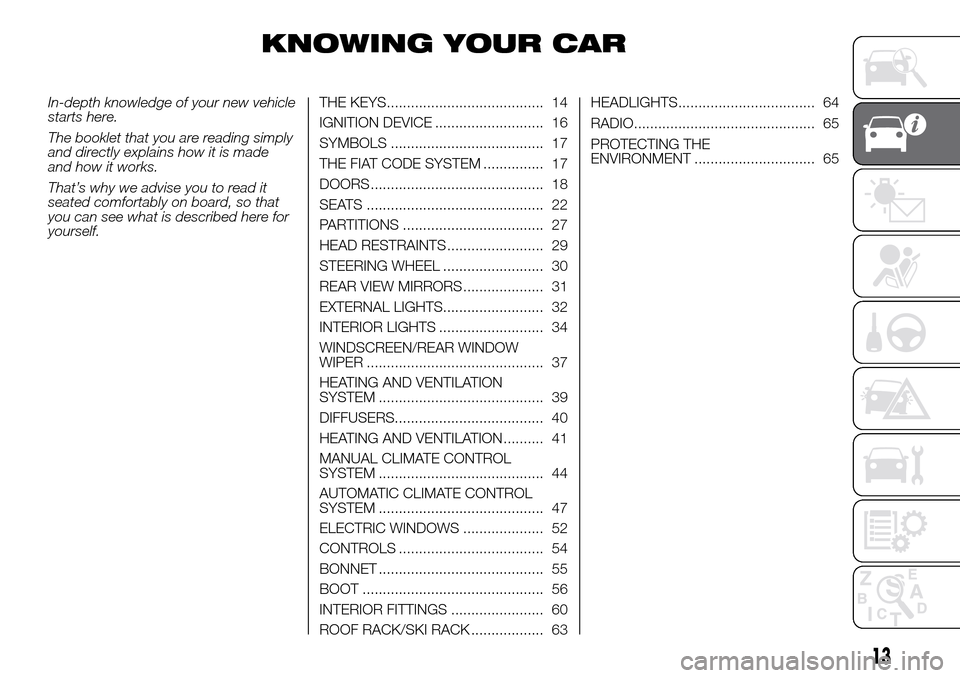
KNOWING YOUR CAR
In-depth knowledge of your new vehicle
starts here.
The booklet that you are reading simply
and directly explains how it is made
and how it works.
That’s why we advise you to read it
seated comfortably on board, so that
you can see what is described here for
yourself.THE KEYS....................................... 14
IGNITION DEVICE ........................... 16
SYMBOLS ...................................... 17
THE FIAT CODE SYSTEM ............... 17
DOORS ........................................... 18
SEATS ............................................ 22
PARTITIONS ................................... 27
HEAD RESTRAINTS ........................ 29
STEERING WHEEL ......................... 30
REAR VIEW MIRRORS .................... 31
EXTERNAL LIGHTS......................... 32
INTERIOR LIGHTS .......................... 34
WINDSCREEN/REAR WINDOW
WIPER ............................................ 37
HEATING AND VENTILATION
SYSTEM ......................................... 39
DIFFUSERS..................................... 40
HEATING AND VENTILATION.......... 41
MANUAL CLIMATE CONTROL
SYSTEM ......................................... 44
AUTOMATIC CLIMATE CONTROL
SYSTEM ......................................... 47
ELECTRIC WINDOWS .................... 52
CONTROLS .................................... 54
BONNET ......................................... 55
BOOT ............................................. 56
INTERIOR FITTINGS ....................... 60
ROOF RACK/SKI RACK .................. 63HEADLIGHTS.................................. 64
RADIO............................................. 65
PROTECTING THE
ENVIRONMENT .............................. 65
13
Page 18 of 298
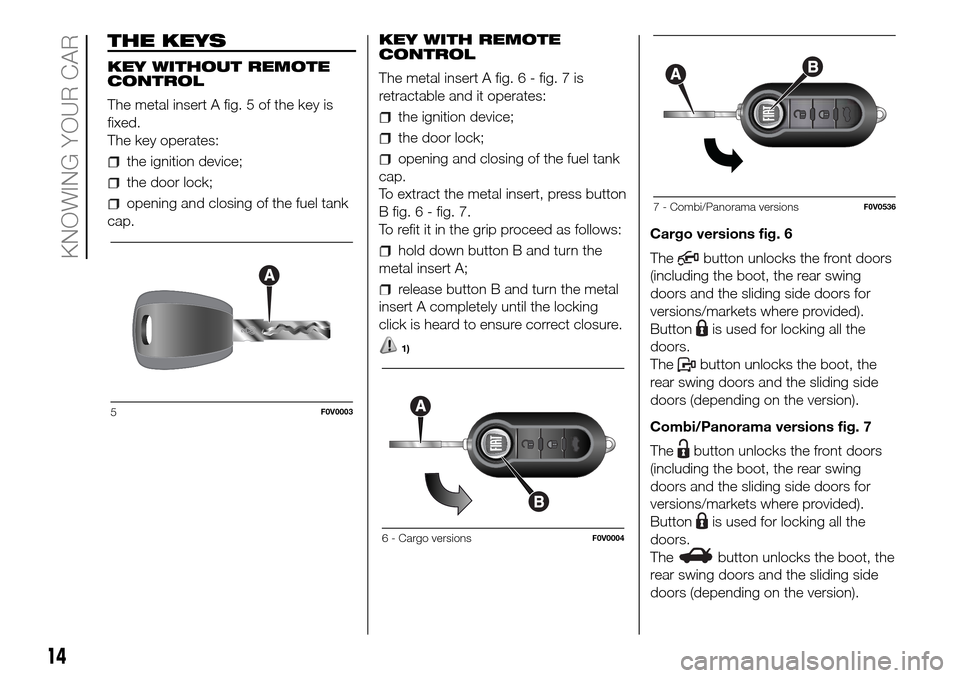
THE KEYS
KEY WITHOUT REMOTE
CONTROL
The metal insert A fig. 5 of the key is
fixed.
The key operates:
the ignition device;
the door lock;
opening and closing of the fuel tank
cap.KEY WITH REMOTE
CONTROL
The metal insert A fig.6-fig.7is
retractable and it operates:
the ignition device;
the door lock;
opening and closing of the fuel tank
cap.
To extract the metal insert, press button
B fig. 6 - fig. 7.
To refit it in the grip proceed as follows:
hold down button B and turn the
metal insert A;
release button B and turn the metal
insert A completely until the locking
click is heard to ensure correct closure.
1)
Cargo versions fig. 6
The
button unlocks the front doors
(including the boot, the rear swing
doors and the sliding side doors for
versions/markets where provided).
Button
is used for locking all the
doors.
The
button unlocks the boot, the
rear swing doors and the sliding side
doors (depending on the version).
Combi/Panorama versions fig. 7
The
button unlocks the front doors
(including the boot, the rear swing
doors and the sliding side doors for
versions/markets where provided).
Button
is used for locking all the
doors.
The
button unlocks the boot, the
rear swing doors and the sliding side
doors (depending on the version).
5F0V0003
6 - Cargo versionsF0V0004
7 - Combi/Panorama versionsF0V0536
14
KNOWING YOUR CAR
Page 60 of 298
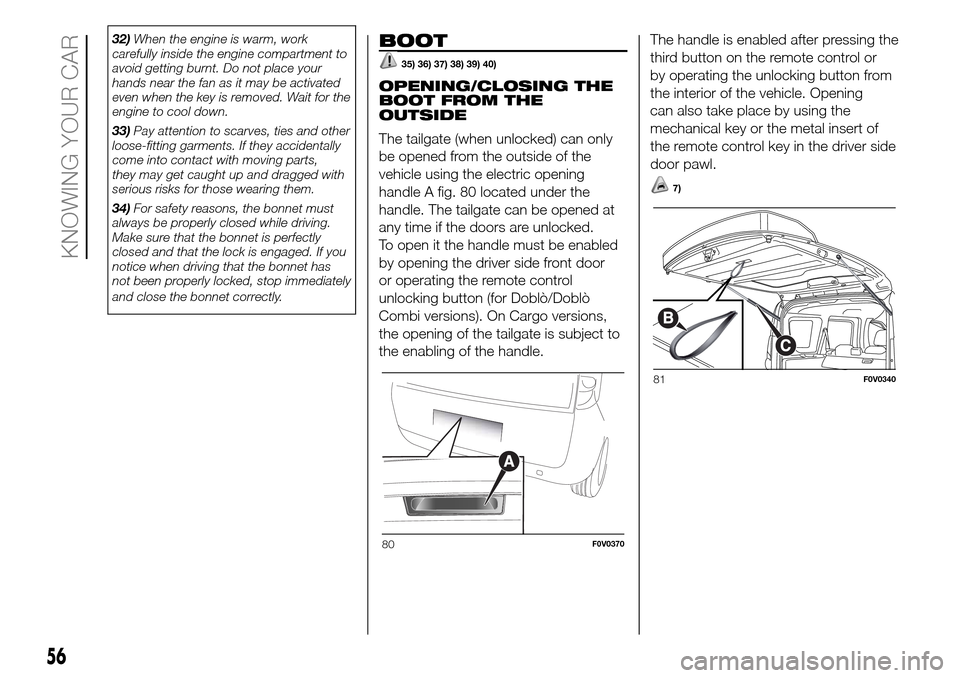
32)When the engine is warm, work
carefully inside the engine compartment to
avoid getting burnt. Do not place your
hands near the fan as it may be activated
even when the key is removed. Wait for the
engine to cool down.
33)Pay attention to scarves, ties and other
loose-fitting garments. If they accidentally
come into contact with moving parts,
they may get caught up and dragged with
serious risks for those wearing them.
34)For safety reasons, the bonnet must
always be properly closed while driving.
Make sure that the bonnet is perfectly
closed and that the lock is engaged. If you
notice when driving that the bonnet has
not been properly locked, stop immediately
and close the bonnet correctly.BOOT
35) 36) 37) 38) 39) 40)
OPENING/CLOSING THE
BOOT FROM THE
OUTSIDE
The tailgate (when unlocked) can only
be opened from the outside of the
vehicle using the electric opening
handle A fig. 80 located under the
handle. The tailgate can be opened at
any time if the doors are unlocked.
To open it the handle must be enabled
by opening the driver side front door
or operating the remote control
unlocking button (for Doblò/Doblò
Combi versions). On Cargo versions,
the opening of the tailgate is subject to
the enabling of the handle.The handle is enabled after pressing the
third button on the remote control or
by operating the unlocking button from
the interior of the vehicle. Opening
can also take place by using the
mechanical key or the metal insert of
the remote control key in the driver side
door pawl.
7)
80F0V0370
81F0V0340
56
KNOWING YOUR CAR
Page 61 of 298
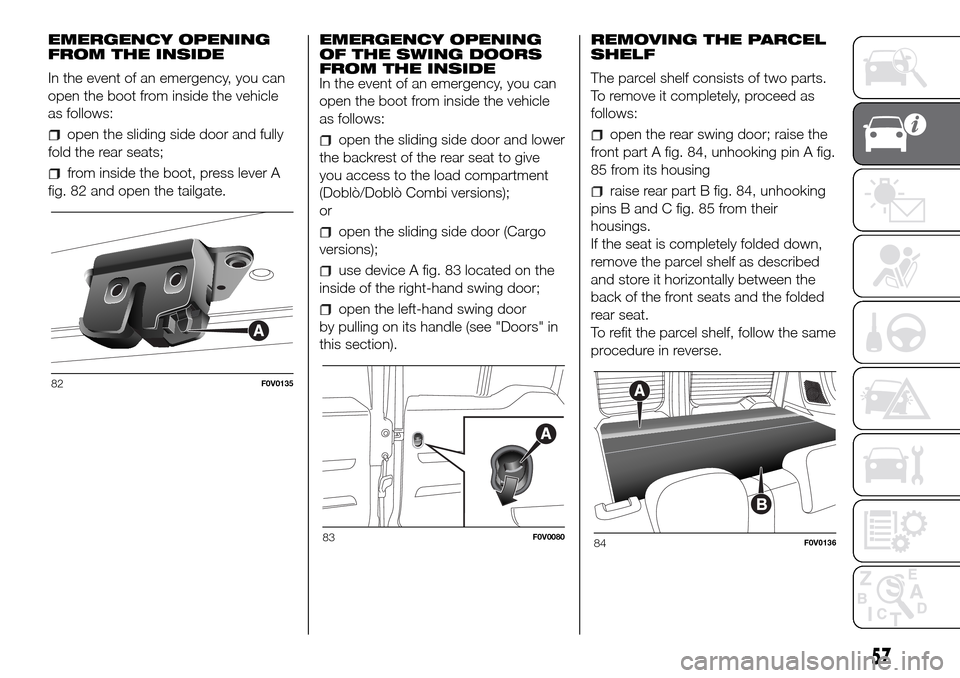
EMERGENCY OPENING
FROM THE INSIDE
In the event of an emergency, you can
open the boot from inside the vehicle
as follows:
open the sliding side door and fully
fold the rear seats;
from inside the boot, press lever A
fig. 82 and open the tailgate.EMERGENCY OPENING
OF THE SWING DOORS
FROM THE INSIDE
In the event of an emergency, you can
open the boot from inside the vehicle
as follows:
open the sliding side door and lower
the backrest of the rear seat to give
you access to the load compartment
(Doblò/Doblò Combi versions);
or
open the sliding side door (Cargo
versions);
use device A fig. 83 located on the
inside of the right-hand swing door;
open the left-hand swing door
by pulling on its handle (see "Doors" in
this section).REMOVING THE PARCEL
SHELF
The parcel shelf consists of two parts.
To remove it completely, proceed as
follows:
open the rear swing door; raise the
front part A fig. 84, unhooking pin A fig.
85 from its housing
raise rear part B fig. 84, unhooking
pins B and C fig. 85 from their
housings.
If the seat is completely folded down,
remove the parcel shelf as described
and store it horizontally between the
back of the front seats and the folded
rear seat.
To refit the parcel shelf, follow the same
procedure in reverse.
82F0V0135
83F0V008084F0V0136
57
Page 62 of 298
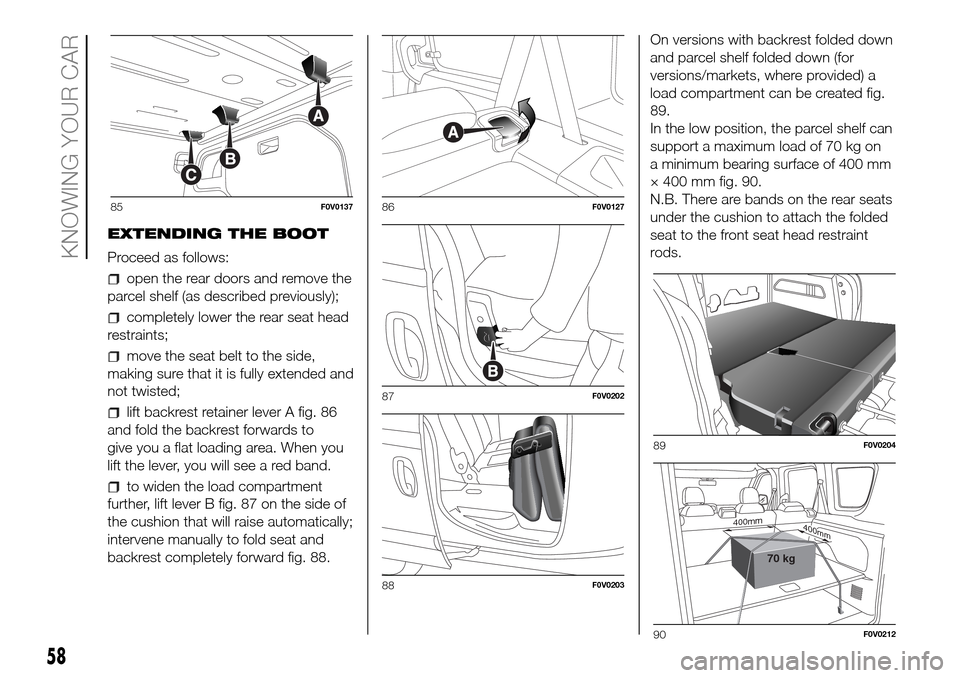
EXTENDING THE BOOT
Proceed as follows:
open the rear doors and remove the
parcel shelf (as described previously);
completely lower the rear seat head
restraints;
move the seat belt to the side,
making sure that it is fully extended and
not twisted;
lift backrest retainer lever A fig. 86
and fold the backrest forwards to
give you a flat loading area. When you
lift the lever, you will see a red band.
to widen the load compartment
further, lift lever B fig. 87 on the side of
the cushion that will raise automatically;
intervene manually to fold seat and
backrest completely forward fig. 88.On versions with backrest folded down
and parcel shelf folded down (for
versions/markets, where provided) a
load compartment can be created fig.
89.
In the low position, the parcel shelf can
support a maximum load of 70 kg on
a minimum bearing surface of 400 mm
× 400 mm fig. 90.
N.B. There are bands on the rear seats
under the cushion to attach the folded
seat to the front seat head restraint
rods.
85F0V013786F0V0127
87F0V0202
88F0V0203
89F0V0204
400mm400mm
70 kg
90F0V0212
58
KNOWING YOUR CAR
Page 63 of 298

SECURING YOUR LOAD
To make it easier to secure your load,
there are hooks (in various quantities
depending on the trim) fixed to the floor
fig. 91 - fig. 92.
WARNING
35)If you are travelling in areas with few
filling stations and you want to transport
fuel in a spare tank, comply with the law by
using only an approved, suitably secured
tank. However, the risks of fire in the case
of collision increase anyway.
36)Never exceed the maximum allowed
load in the boot, see the “Technical
specifications” chapter. Also make sure
that the objects you place in the boot have
been properly secured, to avoid them
from being thrown forward consequent to
sudden braking and injuring your
passengers.
37)If you are travelling in areas with few
filling stations and you want to transport
fuel in a spare tank, comply with the law by
using only an approved, suitably secured
tank. Anyway, by doing so, you increase
the risk of fire in the event of an accident
with your vehicle.
38)Never exceed the maximum allowed
load in the boot (see the "Technical
specifications" chapter). Also make sure
that the objects you place in the boot have
been properly secured, to avoid them
from being thrown forward consequent to
sudden braking and injuring your
passengers.
39)You must not use the folded rear seat
to carry luggage. The load could be thrown
forward into the backrest of the front
seats, seriously injuring the occupants.40)Make sure that the objects are
positioned carefully and fixed to the hooks
on the floor to prevent them being flung
forwards in the event of sharp braking and
causing injury to the passengers.
WARNING
7)To close the tailgate use handle B fig.
81. Do not try to close the tailgate by
pressing on the side shock absorbers C
fig. 81. Also be careful not to knock the
side shock absorbers when you load the
boot, to avoid damaging them.
91F0V0114
92F0V0122
59
Page 92 of 298
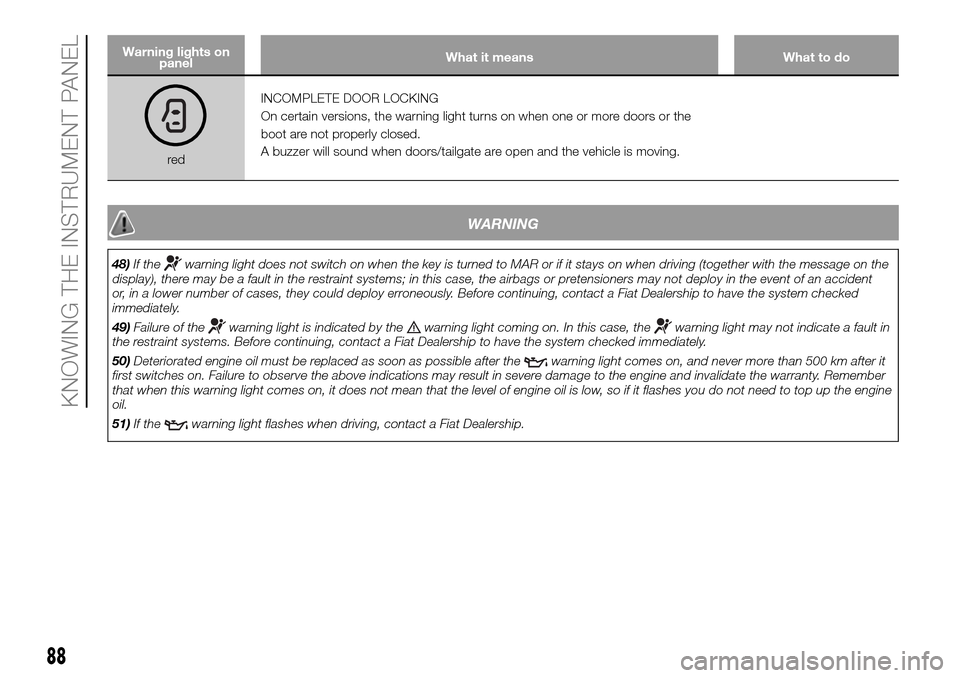
Warning lights on
panelWhat it means What to do
redINCOMPLETE DOOR LOCKING
On certain versions, the warning light turns on when one or more doors or the
boot are not properly closed.
A buzzer will sound when doors/tailgate are open and the vehicle is moving.
WARNING
48)If thewarning light does not switch on when the key is turned to MAR or if it stays on when driving (together with the message on the
display), there may be a fault in the restraint systems; in this case, the airbags or pretensioners may not deploy in the event of an accident
or, in a lower number of cases, they could deploy erroneously. Before continuing, contact a Fiat Dealership to have the system checked
immediately.
49)Failure of the
warning light is indicated by thewarning light coming on. In this case, thewarning light may not indicate a fault in
the restraint systems. Before continuing, contact a Fiat Dealership to have the system checked immediately.
50)Deteriorated engine oil must be replaced as soon as possible after the
warning light comes on, and never more than 500 km after it
first switches on. Failure to observe the above indications may result in severe damage to the engine and invalidate the warranty. Remember
that when this warning light comes on, it does not mean that the level of engine oil is low, so if it flashes you do not need to top up the engine
oil.
51)If the
warning light flashes when driving, contact a Fiat Dealership.
88
KNOWING THE INSTRUMENT PANEL
Page 171 of 298
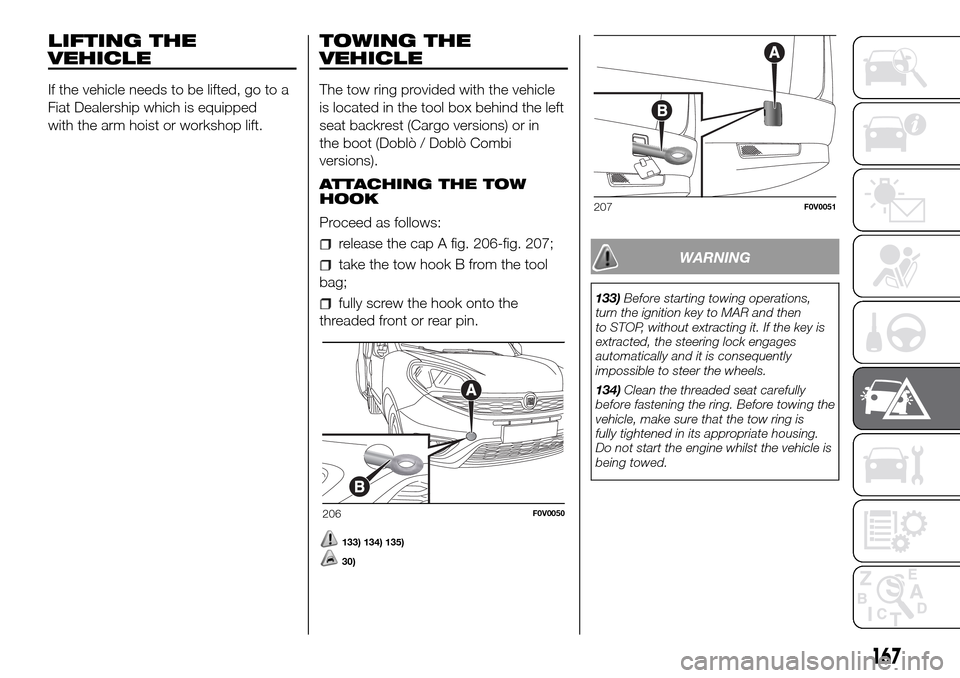
LIFTING THE
VEHICLE
If the vehicle needs to be lifted, go to a
Fiat Dealership which is equipped
with the arm hoist or workshop lift.
TOWING THE
VEHICLE
The tow ring provided with the vehicle
is located in the tool box behind the left
seat backrest (Cargo versions) or in
the boot (Doblò / Doblò Combi
versions).
ATTACHING THE TOW
HOOK
Proceed as follows:
release the cap A fig. 206-fig. 207;
take the tow hook B from the tool
bag;
fully screw the hook onto the
threaded front or rear pin.
133) 134) 135)
30)
WARNING
133)Before starting towing operations,
turn the ignition key to MAR and then
to STOP, without extracting it. If the key is
extracted, the steering lock engages
automatically and it is consequently
impossible to steer the wheels.
134)Clean the threaded seat carefully
before fastening the ring. Before towing the
vehicle, make sure that the tow ring is
fully tightened in its appropriate housing.
Do not start the engine whilst the vehicle is
being towed.
206F0V0050
207F0V0051
167
Page 175 of 298
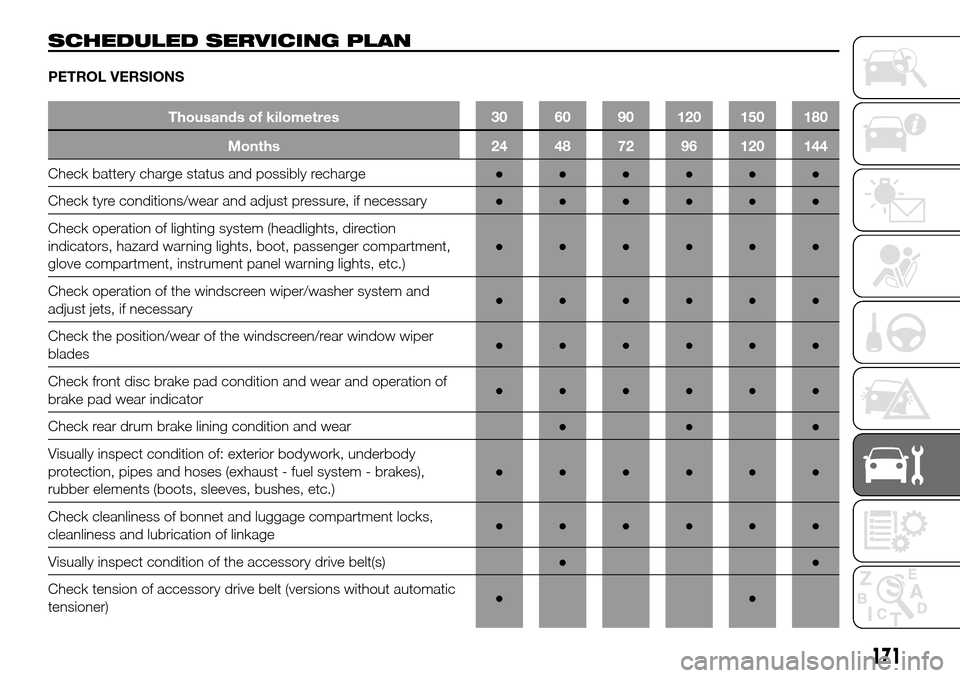
SCHEDULED SERVICING PLAN
PETROL VERSIONS
Thousands of kilometres 30 60 90 120 150 180
Months 24 48 72 96 120 144
Check battery charge status and possibly recharge●●●●●●
Check tyre conditions/wear and adjust pressure, if necessary●●●●●●
Check operation of lighting system (headlights, direction
indicators, hazard warning lights, boot, passenger compartment,
glove compartment, instrument panel warning lights, etc.)●●●●●●
Check operation of the windscreen wiper/washer system and
adjust jets, if necessary●●●●●●
Check the position/wear of the windscreen/rear window wiper
blades●●●●●●
Check front disc brake pad condition and wear and operation of
brake pad wear indicator●●●●●●
Check rear drum brake lining condition and wear●●●
Visually inspect condition of: exterior bodywork, underbody
protection, pipes and hoses (exhaust - fuel system - brakes),
rubber elements (boots, sleeves, bushes, etc.)●●●●●●
Check cleanliness of bonnet and luggage compartment locks,
cleanliness and lubrication of linkage●●●●●●
Visually inspect condition of the accessory drive belt(s)●●
Check tension of accessory drive belt (versions without automatic
tensioner)●●
171
Page 178 of 298
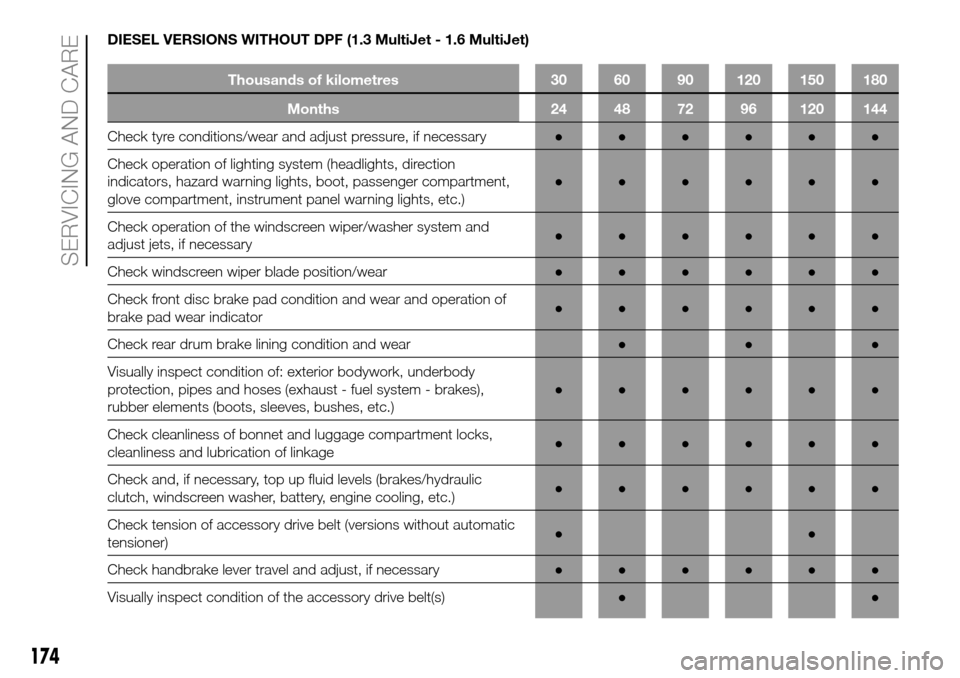
DIESEL VERSIONS WITHOUT DPF (1.3 MultiJet - 1.6 MultiJet)
Thousands of kilometres 30 60 90 120 150 180
Months 24 48 72 96 120 144
Check tyre conditions/wear and adjust pressure, if necessary●●●●●●
Check operation of lighting system (headlights, direction
indicators, hazard warning lights, boot, passenger compartment,
glove compartment, instrument panel warning lights, etc.)●●●●●●
Check operation of the windscreen wiper/washer system and
adjust jets, if necessary●●●●●●
Check windscreen wiper blade position/wear●●●●●●
Check front disc brake pad condition and wear and operation of
brake pad wear indicator●●●●●●
Check rear drum brake lining condition and wear●●●
Visually inspect condition of: exterior bodywork, underbody
protection, pipes and hoses (exhaust - fuel system - brakes),
rubber elements (boots, sleeves, bushes, etc.)●●●●●●
Check cleanliness of bonnet and luggage compartment locks,
cleanliness and lubrication of linkage●●●●●●
Check and, if necessary, top up fluid levels (brakes/hydraulic
clutch, windscreen washer, battery, engine cooling, etc.)●●●●●●
Check tension of accessory drive belt (versions without automatic
tensioner)●●
Check handbrake lever travel and adjust, if necessary●●●●●●
Visually inspect condition of the accessory drive belt(s)●●
174
SERVICING AND CARE